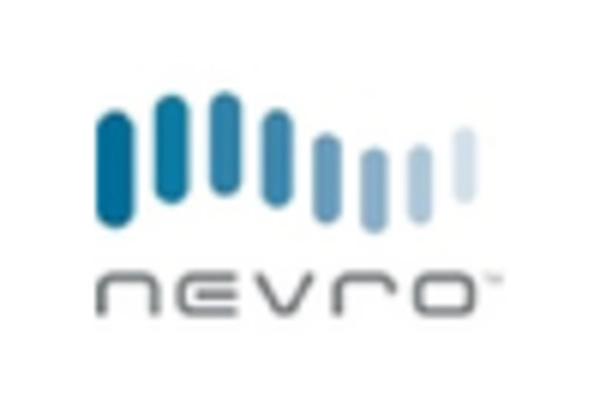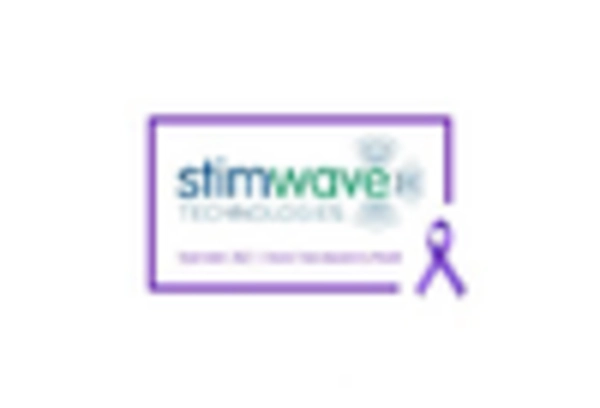Increased Awareness and Education
There is a growing awareness and understanding of spinal cord stimulators among both healthcare professionals and patients in Japan. Educational initiatives and outreach programs are being implemented to inform stakeholders about the benefits and applications of spinal cord stimulation therapy. This increased awareness is crucial, as it helps to dispel misconceptions and encourages patients to consider spinal cord stimulators as a viable treatment option for chronic pain. Furthermore, healthcare providers are becoming more knowledgeable about the indications and contraindications for these devices, leading to more informed decision-making. As awareness continues to rise, it is anticipated that the spinal cord-stimulator market will experience increased demand, as more patients seek out these innovative solutions for pain management.
Rising Prevalence of Chronic Pain
The increasing incidence of chronic pain conditions in Japan is a primary driver for the spinal cord-stimulator market. Conditions such as neuropathic pain, fibromyalgia, and failed back surgery syndrome are becoming more prevalent, affecting a significant portion of the population. According to recent health statistics, approximately 20% of adults in Japan experience chronic pain, which necessitates effective pain management solutions. Spinal cord stimulators offer a minimally invasive option for patients who do not respond to conventional therapies. This growing patient population is likely to propel demand for spinal cord stimulators, as healthcare providers seek innovative solutions to improve quality of life and reduce reliance on opioid medications. As a result, the spinal cord-stimulator market is expected to expand in response to this rising need for effective pain management alternatives.
Supportive Reimbursement Policies
The reimbursement landscape for spinal cord stimulators in Japan is evolving, with supportive policies being established to facilitate access to these devices. Insurance coverage for spinal cord stimulation therapy is becoming more comprehensive, which is likely to encourage both patients and healthcare providers to consider this treatment option. The Japanese government has recognized the importance of addressing chronic pain and is taking steps to ensure that effective therapies are accessible to those in need. As reimbursement policies become more favorable, the financial burden on patients decreases, making spinal cord stimulators a more attractive option. This trend is expected to drive growth in the spinal cord-stimulator market, as increased accessibility leads to higher adoption rates among patients seeking relief from chronic pain.
Technological Innovations in Device Design
Technological advancements in the design and functionality of spinal cord stimulators are significantly influencing the market in Japan. Innovations such as wireless connectivity, rechargeable batteries, and advanced programming capabilities enhance the usability and effectiveness of these devices. For instance, the introduction of closed-loop systems that automatically adjust stimulation based on real-time feedback from the patient represents a major leap forward. These innovations not only improve patient outcomes but also increase the appeal of spinal cord stimulators among healthcare providers. The market is witnessing a shift towards more sophisticated devices that offer personalized treatment options, which could potentially lead to a higher adoption rate. As a result, the spinal cord-stimulator market is likely to benefit from ongoing research and development efforts aimed at enhancing device performance and patient satisfaction.
Growing Investment in Healthcare Infrastructure
Japan's commitment to enhancing its healthcare infrastructure is a significant driver for the spinal cord-stimulator market. The government is investing in advanced medical technologies and facilities to improve patient care and outcomes. This investment includes the expansion of specialized pain management clinics and the integration of cutting-edge medical devices into treatment protocols. As healthcare facilities upgrade their capabilities, the demand for innovative solutions such as spinal cord stimulators is likely to increase. Furthermore, the emphasis on patient-centered care aligns with the benefits offered by spinal cord stimulation therapy, which focuses on improving quality of life. Consequently, the spinal cord-stimulator market is poised for growth as healthcare infrastructure continues to evolve and adapt to the needs of patients.

















Leave a Comment